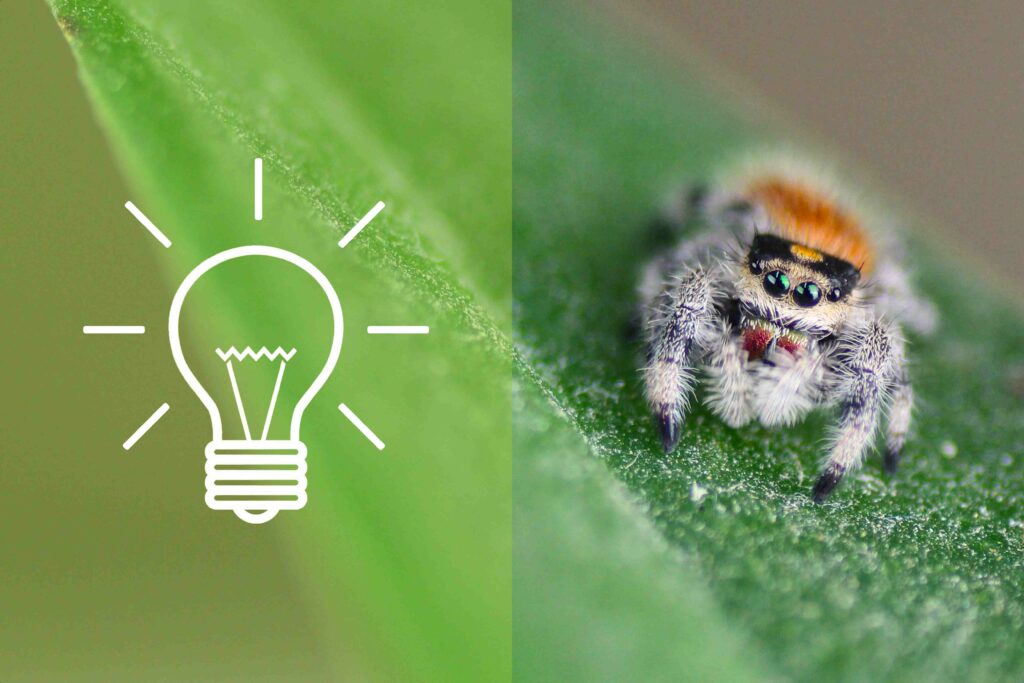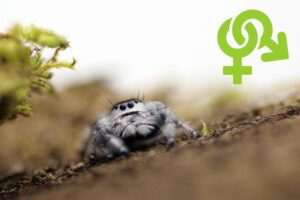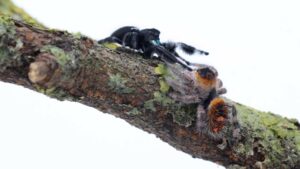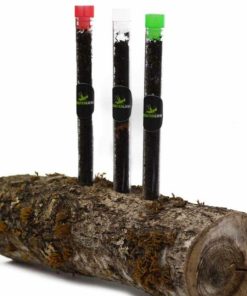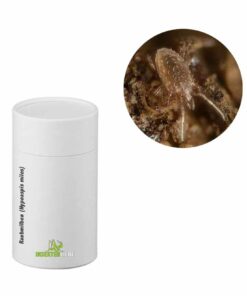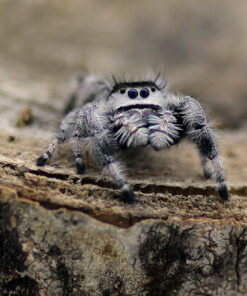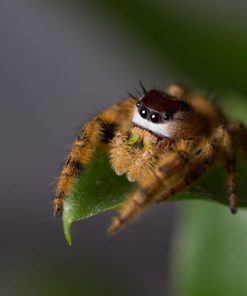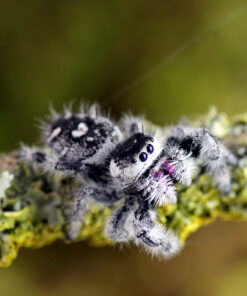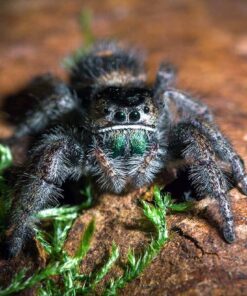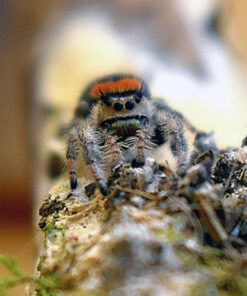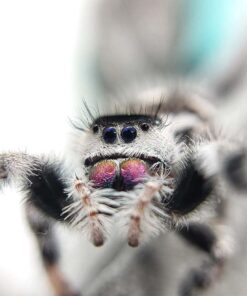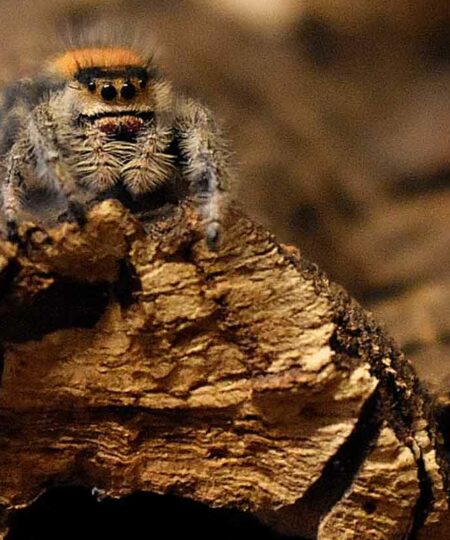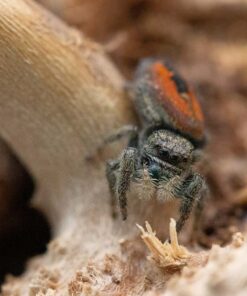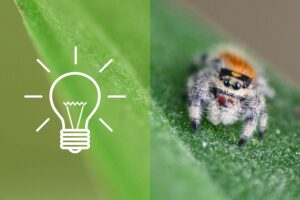Jumping spiders -Magazine
The most frequently asked questions about keeping jumping spiders: Here you will find the answers!
In advance, we would like to point out our Jumping spiders -Magazine, which already covers many questions and topics.
More information about this spider:

Basic terms and developmental stages in jumping spiders
Question: What does the abbreviation „L” mean in spiders and what role does the number behind it play?
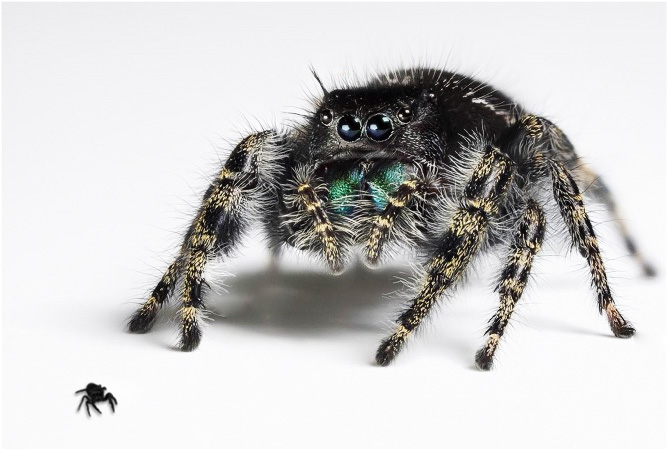
The photo clearly displays an adult female jumping spider positioned next to a tiny, delicate L1 spiderling.
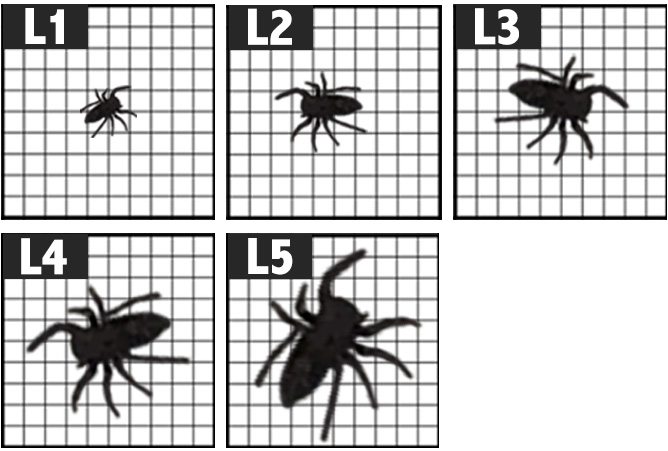
The photo shows different developmental stages of a jumping spider – from L1 to L5- on graph paper.
Question: What do the terms juvenile, pre-subadult, subadult and adult describe in jumping spiders?
Answer: The terms mentioned refer to different developmental stages of jumping spiders and have their origin in Latin.
- Adult: This word means “adult”. An adult jumping spider is accordingly sexually mature and has reached its full size.
- Subadult: This can be translated as “half-grown”. In terraristics, this term denotes a jumping spider that is exactly one moult before reaching sexual maturity.
- Pre-subadult: This is a stage that is still one moult before the subadult stage. This means that the spider still has to go through two moults before it becomes sexually mature.
- Juvenile: Translated, this means “youthful”. In jumping spiders, it indicates that the animal has reached an intermediate size but is not yet approaching the later stages of development.
- Slings: The term “slings” is widely used in terraristics and refers to the youngest, just-hatched spiders, especially in tarantulas and jumping spiders. Thus, when speaking of a “sling”, a baby spider is meant. At this early stage of development, the animals are particularly sensitive and require special attention in terms of husbandry and care. Their tiny body and fine limbs are not yet as robust as older specimens.
With these terms, keepers can better assess the stage of development of their jumping spiders and adjust their care accordingly.

Moulting and development in jumping spiders
Question: How often does a jumping spider shed its skin in the course of its life?
Answer: The number of moults a jumping spider goes through in its lifetime varies and cannot be determined across the board. Male jumping spiders generally need 1 to 2 moults less for sexual maturity than their female conspecifics. It happens that female jumping spiders of the same species become sexually mature after the 8th moult, while others only reach this stage after the 9th moult. It is therefore important to keep an eye on the stage of development and the individual needs of each spider.
Question: How much time does a jumping spider need to become sexually mature?
Answer: Typically, a jumping spider becomes sexually mature within about a year, but this time frame can be influenced by several factors. Two of the most important factors are the ambient temperature and the food supply. Jumping spiders are cold-blooded organisms. This means they do not have the ability to regulate their body temperature independently, but are dependent on the conditions of their environment. Warmer ambient temperatures boost their metabolism, which can accelerate their development and growth. At the same time, a regular and nutritious food supply can positively influence the spider’s development. It is therefore essential to keep an eye on both temperature and nutrition to ensure the optimal development of the jumping spider.
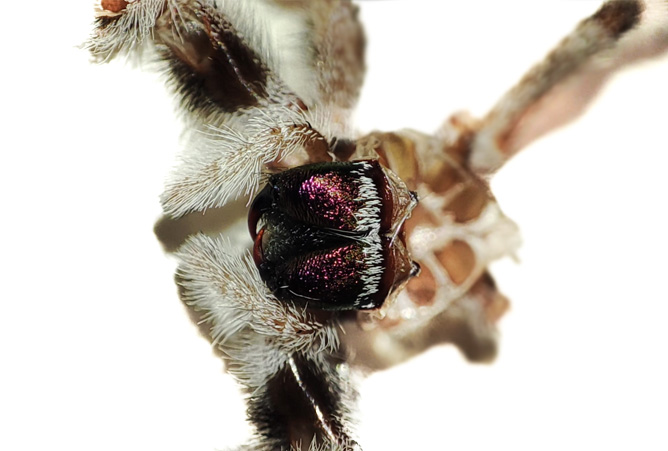
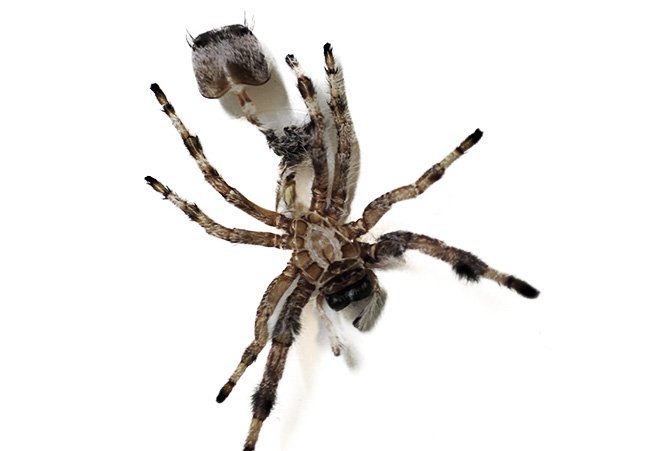
Question: When should I feed after a moult?
Answer: Moulting is an intensive process for jumping spiders, during which they shed their old exoskeleton and form a new one. In the phase immediately after moulting, their skin is particularly soft and sensitive. Therefore, it is important to give them time to recover and let their new exoskeleton strengthen. A good indication that the spider is ready to feed again can be seen in its behaviour: As soon as the jumping spider emerges from its hiding place and starts actively exploring, this is a sign that it is fit again and can be fed.
Question: How long does the moulting process take in a jumping spider?
Answer: The actual moulting process takes up to one hour. However, the preparation time before and the subsequent recovery phase should not be underestimated – together they can take up to two weeks. The exact period of time depends on the respective developmental phase (L) the spider is in. The decisive factor is the age of the animals: with increasing age, the entire moulting process tends to take longer.
Question: My jumping spider has lost a leg after moulting. What can I do?
Answer: Don’t worry, spiders have the amazing ability to regrow lost limbs after several moults. If kept too dry during moulting, limbs can get stuck in the old skin. Therefore, it is important to pay special attention to humidity of about 70% during the next moult. In the meantime, observe whether your jumping spider can move normally and eats without problems. With the following moults, the leg will regenerate completely.

Husbandry and housing
Question: Do I really need double ventilation in the terrarium?
Answer: Yes, double ventilation is indeed essential. It prevents the formation of waterlogging in the terrarium, which can be dangerous for jumping spiders. A lack of adequate ventilation can lead to excessive humidity, and this waterlogging can ultimately lead to the death of your jumping spider. It is therefore in the best interest of your animal to ensure that the terrarium is well ventilated.
Question: Why are there mites in my jumping spider terrarium?
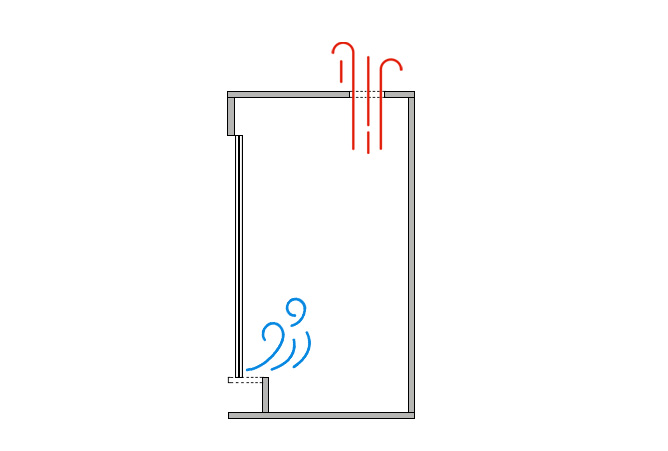
The chimney effect in the terrarium is the rising of warm air and the drawing in of cooler air from below.
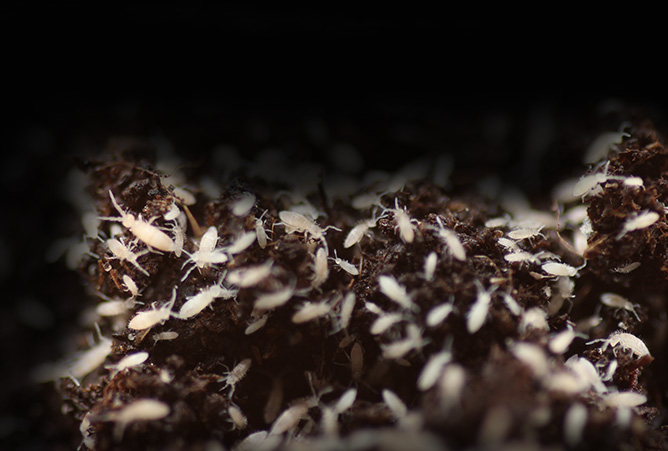
Springtails in terrariums, consume decaying matter and prevent mold growth, ensuring a healthier habitat.
Question: Why shouldn’t I immediately put a jumping spider into a regular terrarium?
Answer: In the L3 stage, jumping spiders are only a few millimetres in size. A conventional terrarium often has cut-outs, for example for cables, as well as ventilation holes and sometimes also small gaps between the glass panes. These places provide ideal escape routes for both the small jumping spiders and their food animals. It is therefore advisable to house the spiders in a special, well-sealed rearing terrarium until they reach their L6 stage, to prevent escape.
Question: I cannot keep the humidity in my jumping spider terrarium constant? What can I do about it?

Nutrition and behaviour
Question: How often should jumping spiders be fed?
Answer: In the first stages of development, more precisely up to stage L5, jumping spiders have a relatively high food requirement. Therefore, we recommend offering them food every 3 days during this period. This ensures that they get all the necessary nutrients for healthy growth. As the spider gets bigger, its metabolism slows down a little. Accordingly, the feeding interval can be adjusted as the spider grows larger. It is then sufficient to feed them only once a week. However, it is always important to observe the behaviour and feeding habits of your own jumping spider to ensure that it is being fed optimally.
Question: Should I feed even if my jumping spider is in the web and hasn’t eaten for days?
Answer: I understand your concern if your jumping spider does not eat for several days and hides in the web. But you should know that sometimes jumping spiders have periods when they are less active or withdraw. This can be for various reasons, such as an impending moult. You should offer food especially when the spider is actively foraging. If your jumping spider hides in the web and makes no effort to come out, then it is better to wait before feeding. Feeding animals can cause more stress for the spider at such times. Continue to monitor your jumping spider and offer food as soon as you notice increased activity.
Question: Why is my spider only sitting in the spider web?
Question: Why doesn’t my jumping spider eat even though it is thin?

Reproduction and lifespan
Question: Is it normal for my jumping spider to build a cocoon even though I haven’t mated it?
Answer: Yes, this is indeed normal. Female jumping spiders have the genetic predisposition to lay eggs and build a cocoon accordingly – even without prior fertilisation. In such cases, the cocoon contains unfertilised eggs. There will only be offspring if fertilisation has taken place beforehand. The unfertilised eggs will die after a few days. As a rule, the jumping spider will reject the cocoon containing no viable eggs on its own.
Question: How long does a jumping spider live?
Answer: The lifespan of jumping spiders is variable and can vary according to sex, although exceptions are not uncommon. While female jumping spiders often live longer, producing 4-5 cocoons in their lifetime, males typically reach their mature moult after 6 months, depending on temperature and food supply. Although many male jumping spiders die within 12 months of breeding, giving them an average age of around 18 months, there are still males that reach an age of up to 2 years, similar to their female conspecifics. Individual differences must therefore be taken into account.

More jumping spiders articles
If there are any further questions, feel free to ask them below the article in the comments.



